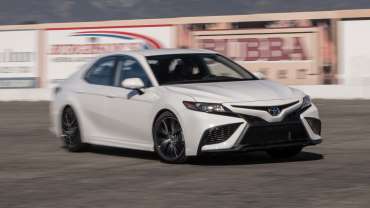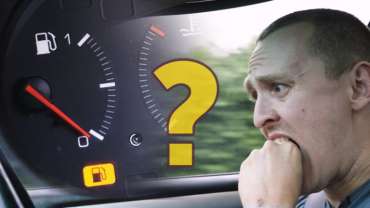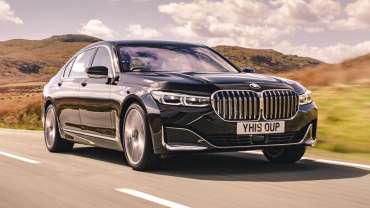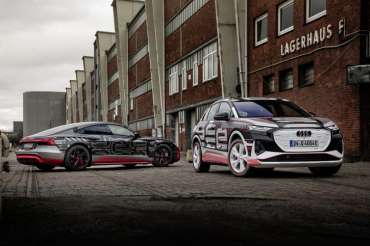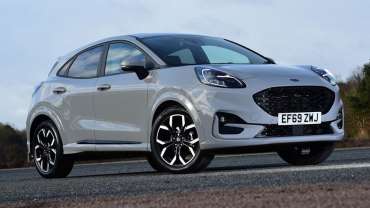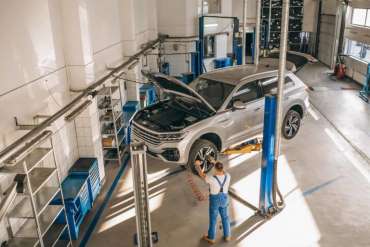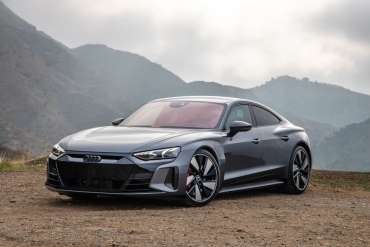
Worldcarblog.com
2021 Toyota Camry SE First Test: Is Good Enough Good Enough?
The competition is stronger than ever. Can a refreshed Camry hold its own?
We all know why the Toyota Camry is the default for many when they need point A to point B transportation. It's well-priced and spacious, carries Toyota's reputation for reliability, and has almost always ranged from decent looking to, today, actually handsome. But the midsize sedan segment has recently been shaken up. The new Kia K5 and Hyundai Sonata (among others) all represent stiffer competition than ever before, and we were left wondering: Can the refreshed-for-2021 Toyota Camry keep up with its revitalized rivals?
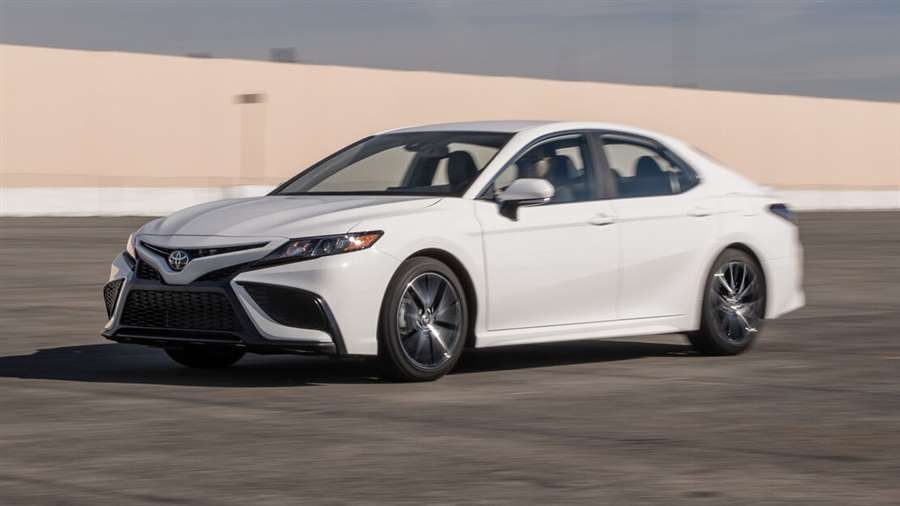
On paper, the answer is yes. The Camry's SE's 2.5-liter naturally aspirated I-4 makes a healthy 203 horsepower and 184 lb-ft of torque. That makes it the least powerful Camry on sale, but on the flip side, also gives it a relatively large 23-hp power advantage over competition like the Kia K5 and the Hyundai Sonata. Both of those cars use a 1.6-liter turbocharged four-cylinder that kicks out 180 horsepower as their base powertrain. And so the SE-trimmed car we had for this test punched above its weight, something MotorTrend en Español editor Miguel Cortina felt from the seat of his pants. "The engine and the transmission feel like they are eager all the time, sometimes too eager," Cortina said. "However, that's not necessarily bad. I'd rather complain about the throttle response being a bit too aggressive than sluggish. The Camry doesn't feel like that. It delivers on the basics without falling short."
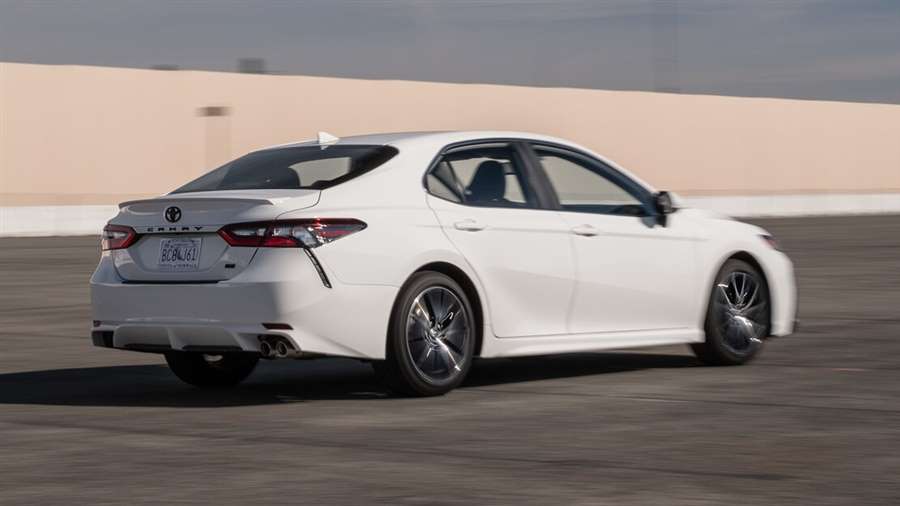
Cortina's impressions on the road were backed up at our test track. At 7.5 seconds to 60 mph, the Camry SE is 0.3 second quicker to 60 than either a K5 EX or a Sonata SEL Plus. The gap is just 0.1 second smaller in the quarter-mile, with the Camry running all 1,320 feet in 15.8 seconds and the aforementioned Koreans doing the job in 16 seconds flat. The longtime rival Honda Accord, however, manages a quicker 0-to-60 time of 7.2 seconds and finishes the quarter mile in 15.5 seconds despite having 11 fewer horses in the stable.
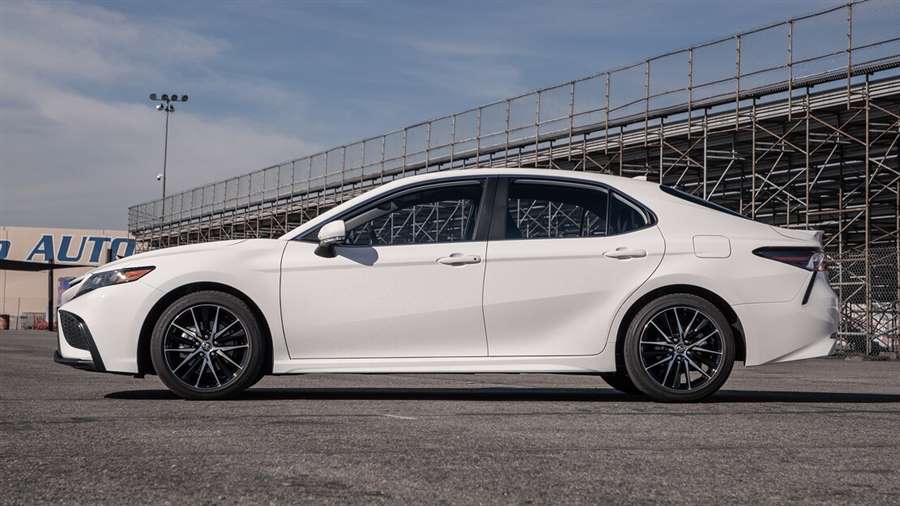
Move from the drag strip to the skidpad, and the SE-trimmed Camry still impressed. Family sedans like the Camry SE, Sonata SEL, and K5 EX are never going to be handling all-stars—the exceptional Honda Accord notwithstanding—but the Toyota impressed road test editor Chris Walton once he started hooning it around our figure-eight test. "This car is surprisingly fun and capable on the figure eight," Walton said. "The firm brake pedal remains trustworthy lap after lap, and it's easy to modulate. There's no funky emergency braking ABS; the brakes release when I release. The steering weight is just right and feels reasonably natural. There's exceptional balance on the skidpad, vacillating between rotation and understeer, where the ESC nibbles away to straighten it out without throwing the anchor."
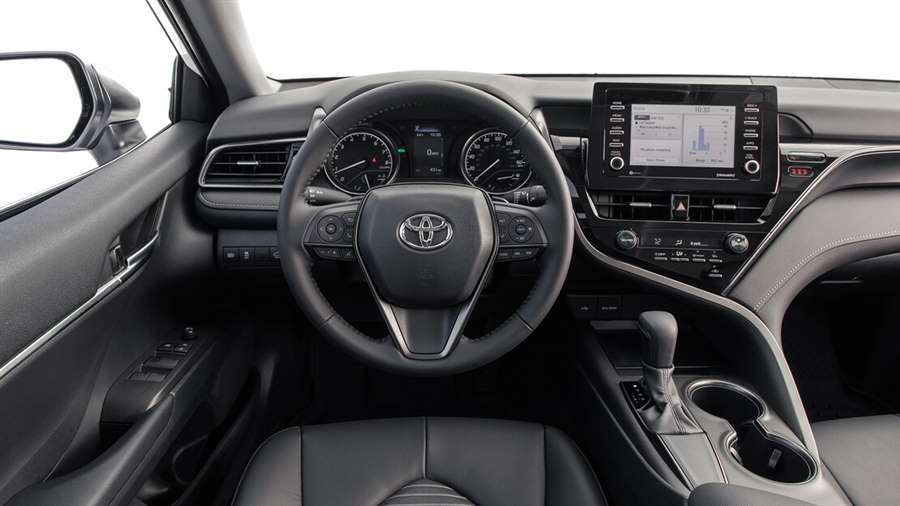
Yet again, the numbers back up our gut feeling. The Camry is a solid contender when stacked up against the competition, which either ties our Camry or ekes out a marginal advantage. The Toyota managed a figure-eight time of 27.4 seconds at a 0.62 g average, exactly the same time as the Kia K5 EX. The Accord EX-L we recently tested, however, is a respectable 0.3 second quicker around the lap and managed a marginally better 0.63 g average.
The Camry's agility translates to the road, too. Senior features editor Jonny Lieberman said the Camry is "better to drive than it needs to be" but noted that it's "not nearly as good to drive as the Accord," an impression supported by numerous other voices on staff. In fact, most of us were impressed with the way the Camry went down a road but noted the Accord is still the better handler.
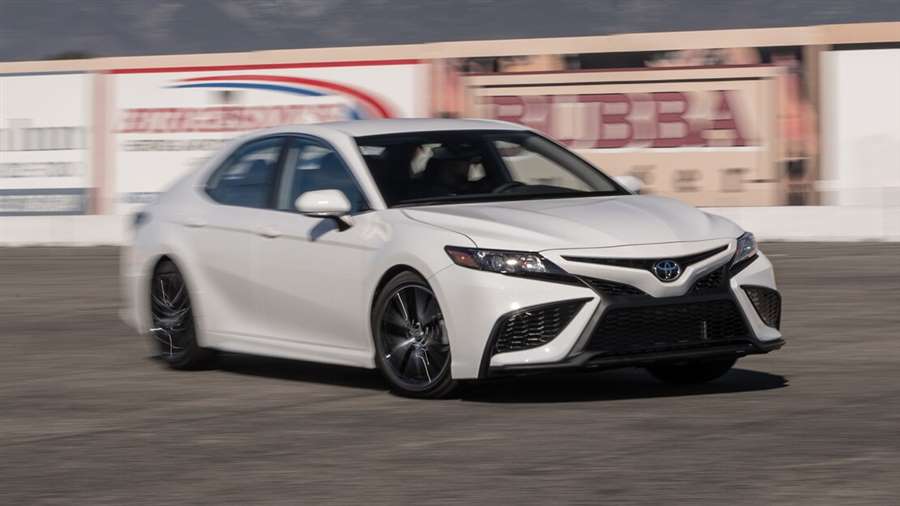
Niceties that exist in every Camry are present in this low-spec SE model. The trunk makes loading and unloading easy with a massive aperture and offers up 15.1 cubic feet of free space to play with. A comfortable seating position is easy to find, and ingress and egress are a snap, too. In addition, the gauges are clear and easy to read, there's ample leg- and headroom in the second row for passengers, and a cushy suspension tune is perfect for those who prefer their family sedans to waft down the road.
Letdowns? In this SE, there's the low-rent interior and dated infotainment display, despite the recent refresh. The soft suspension doesn't control the body as well as we'd like overall, leading to more pronounced up and down motions over high-amplitude bumps, and there's pronounced wind and tire noise in the cabin. All in all, though, the midsize family sedan segment might be more competitive than it's ever been, and the Camry is a solid performer. There are better choices, but for our car's $29,217 as-tested price, you could certainly do worse.
What will happen to the car engine if you run out of fuel while driving ?!
It happens, it is not uncommon… Forget it, you are bothered by worries at work or in the family and you simply run out of fuel while driving. Can anything happen to a car, that is, can major breakdowns occur?
In older cars, if you run out of fuel, breakdowns on injectors and diesel fuel pumps are possible.
Car manufacturers claim that their new models are so constructed that there will be no problem if you run out of fuel. That is, there should be no engine failures. Nevertheless, do not wait for the tank to empty, as dirt from the bottom of the tank will be injected into the system. They should be taken care of by a fuel filter, ie prevented from entering the engine, but it is better not to cause happiness.
In older cars, if you run out of fuel, breakdowns on injectors and diesel fuel pumps are possible. Basically, always react on time and drive to the nearest gas station.
BMW 7 Series saloon review
"The latest BMW 7 Series sports a brash new grille, improved powertrains and even more tech"
This is the sixth-generation of the BMW 7 Series luxury saloon and arguably the most identifiable, thanks to its bold new face. BMW clearly decided its conservative flagship saloon needed to stand out against the stately Mercedes S-Class and forward-looking Audi A8, increasing the size of its kidney grille by around 40%.
Elsewhere the makeover is far less dramatic, with slim new headlights and a full-width LED rear light-bar representing the most noticeable changes. It also has a smoother overall look and has been tweaked to suit the Chinese market, where more than a third of all 7 Series are sold.
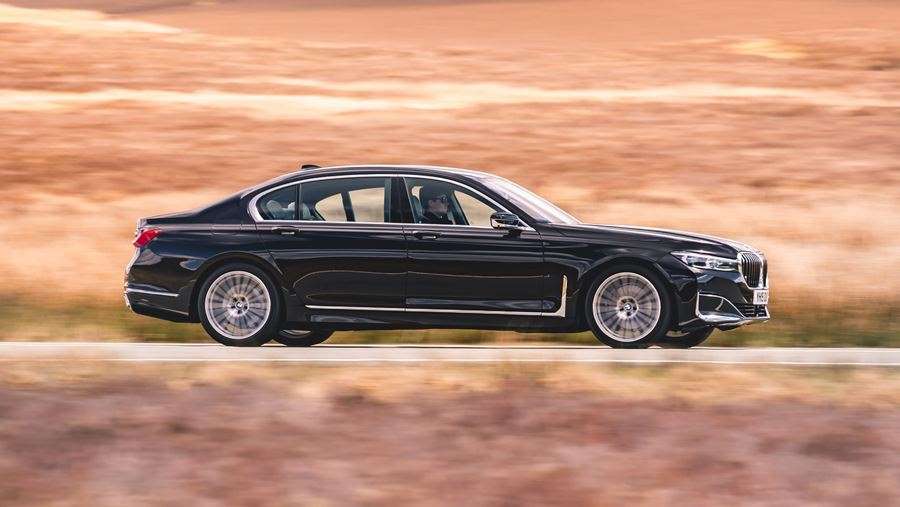
The interior has also been reworked with a light touch, leaving most of its design intact but revisiting the tech on offer. The start of the show is BMW's latest infotainment system, bringing digital instruments and an updated tablet that passengers in the back can use to control the car's interior features.
Depending on its expected use, the 7 Series can be specified with a standard or long wheelbase to boost passenger space, along with either a bench rear seat or two-seat 'lounge' setup. The latter brings the full VIP experience, with individual seats that are heated, cooled and reclining either side of a centre console.
For a car that doesn’t sell in huge numbers, there's a wide range of engines, spanning from a plug-in hybrid model to diesels, and even a flagship V8 petrol. Every 7 Series is quick and supremely comfortable, but the range-topping petrols are also powerful for a large saloon, and the BMW has a sportier edge than the Mercedes S-Class.
BMW 7 Series saloon - MPG, running costs & CO2
The plug-in hybrid and diesel models make the big BMW 7 Series surprisingly efficient
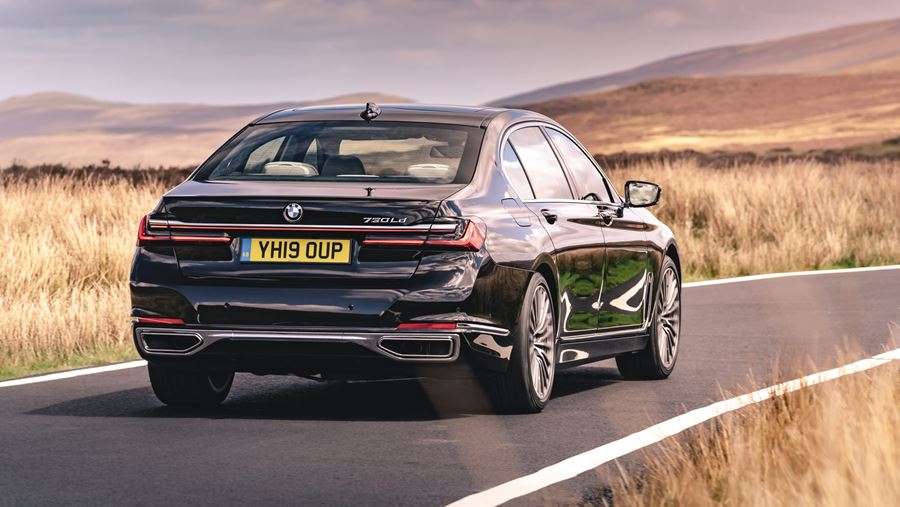
Thanks to the breadth of the BMW 7 Series' engine range, there should be a version to suit every customer and location. We say ‘location’ because the plug-in hybrid 745e will bring real advantages in terms of taxes and charges if the owner drives into cities like London with low-emission zones and tariffs.
For this reason, the 745e plug-in hybrid is popular thanks to its CO2 emissions from 41g/km and fuel economy of up to 156.9mpg. The exact economy you get will depend on how often you can charge its battery pack and make use of its 28 mile electric range, but its fixed emissions figure gives the car free access to city centres with low-emission zones. A low Benefit-in-Kind (BiK) company-car tax will also appeal to business users.
The 7 Series’ standard petrol models are considerably pricier to run. The 740i returns up to 35.8mpg and emits from 180g/km, while the hugely powerful 750i xDrive returns little over 25mpg and sits in the top BiK tax band for business drivers.
Diesel engines are still very popular for the 7 Series, and the 730d will especially suit high-mileage drivers. Fuel economy of up to 51.4mpg is pretty impressive given the BMW's size, but emissions from 144g/km (with the smallest alloy wheels fitted) mean it still sits in a high BiK tax band. The 740d still returns 47mpg despite posting a very quick acceleration time and getting four-wheel drive. It features mild-hybrid technology with a small battery that stores the energy harvested from braking and deceleration, which is then used to give the engine a boost helping to improve fuel economy and emissions.
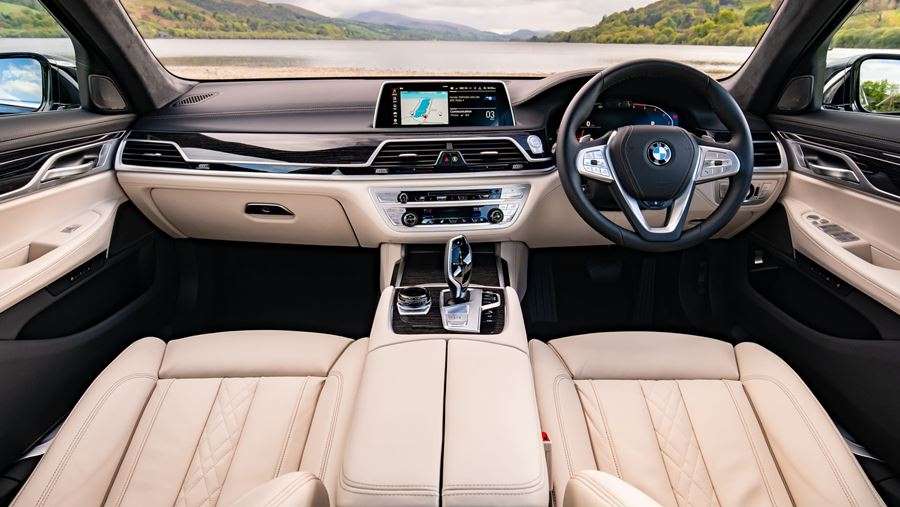
Insurance groups
Insurance groups for the BMW 7 Series saloon are high because of how much it costs, the complex engineering and high performance. Even models lower down the range, such as the 740i are in insurance groups 48 or 49. Every other model, including all long wheel variants and even the 745e hybrid, sit in the top insurance group 50.
Warranty
All BMW models come with a three-year warranty that's typical amongst the German brands, however it does also have unlimited mileage within this period.
Servicing
BMW offers servicing packages that can be purchased when the car is new, covering maintenance for a fixed cost for a set period of time, for up to five years, which can also be transferred to subsequent owners.
Servicing packages can also be extended to include consumable items like brake pads, discs and a new clutch for an extra charge.
BMW 7 Series saloon - Engines, drive & performance
While still comfortable, the BMW 7 Series is a bit more involving to drive than most large saloons
Unlike most BMW models, the 7 Series favours a plush ride over sporty handling, but it still feels lighter on its toes than the Audi A8 or Mercedes S-Class. This is partly thanks to use of a carbon fibre 'core' running through its underpinnings, which helps save weight and increase structural stiffness.
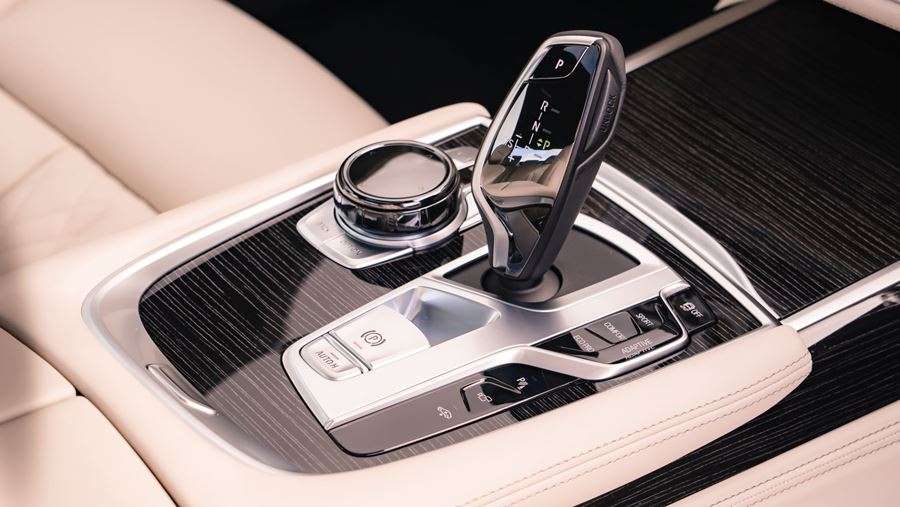
In any of its driving modes and any scenario, the 7 Series is incredibly comfortable. We found the normal Comfort mode to be the best all-round setting; Comfort Plus makes the air suspension even softer, but this can make the body feel a little wayward on demanding roads, so is probably best left for the motorway.
BMW 7 Series diesel engines
There are two versions of the same 3.0-litre straight-six diesel, and the BMW 730d has traditionally been the bestseller in Britain. It has 282bhp and manages 0-62mph in 5.9 seconds when equipped with rear-wheel drive, with the xDrive four-wheel drive version taking 5.6 seconds. The more powerful four-wheel drive 740d gets 335bhp, and manages to get from 0-62mph in only five seconds. BMW’s mild-hybrid technology is fitted to both models, which provides an extra 11bhp overboost under full throttle to aid acceleration.
Petrol engines
The petrol line-up consists of one relatively normal straight-six, and two much more expensive to run, powerful and exotic engines. With 328bhp, the 740i engine is shared with models including the BMW 3 Series and BMW 5 Series, and still proves spritely in a bigger vehicle, getting the 7 Series from 0-62mph in 5.5 seconds.
BMW 7 Series saloon - rear 3/4 dynamic 17
An all-new 4.4-litre V8 offered in the 750i creates a thunderous 528bhp and gets the car from 0-62mph in four seconds, aided by four-wheel drive traction. Despite its extra size and four extra cylinders, the 577bhp 6.6-litre V12 in the M760Li could only shave 0.2 seconds off the 0-62mph sprint, and has now been discontinued in the UK.
Hybrid engines
While the 730d has long been the most popular model, a shift away from diesel and heavy taxation means the 745e plug-in hybrid is likely to win favour with business buyers - who make up the bulk of 7 Series customers. It combines a six-cylinder petrol engine with an electric motor and battery pack, providing an electric-only driving range of up to 28 miles. Zero-to-62mph takes a fraction over five seconds.
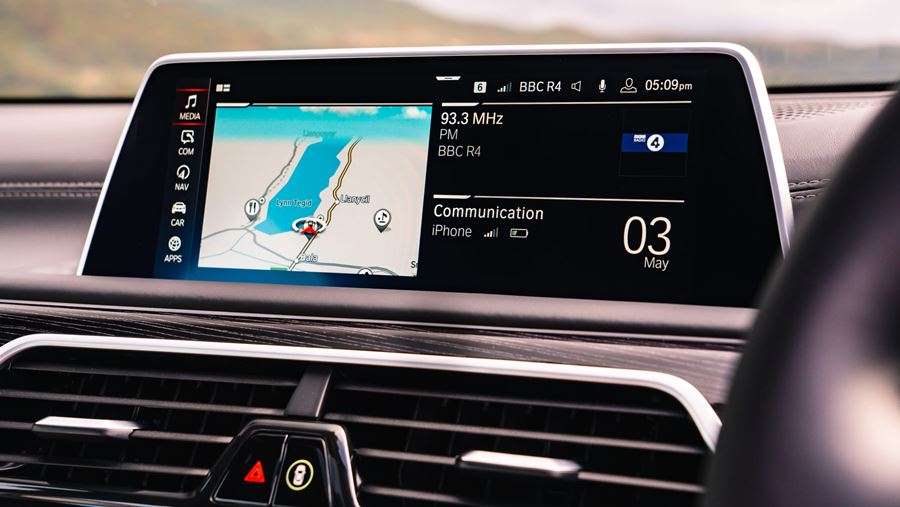
BMW 7 Series saloon - Interior & comfort
Technology has been improved with a better infotainment system and rear seat entertainment
Aside from its grille, the BMW 7 Series and its rivals are known for being conservative, and the interior hasn't changed too much from its predecessor. Of course, technology has been bolstered, so every gadget you can think of is standard or available as an option.
BMW 7 Series dashboard
While it looks pretty similar, there's a new set of digital instruments that can show much more information to the driver. Materials have also been updated to keep the 7 Series near the front of the pack, with every surface covered in leather or wooden trim, including oak and polar.
Equipment
Perhaps most importantly, the infotainment system runs BMW's Operating System 7.0, bringing the latest connectivity, media and navigation to the driver and passengers via seven-inch removable tablets.
Choose the 730d and so much is included you'd be hard pressed to tell it's officially the entry-level model. A Harman Kardon stereo, adaptive LED headlights, powered boot, wireless phone charging and a key with its own display are all standard.
BMW 7 Series saloon - infotainment 17
In-car technology doesn’t disappoint either, with all models coming as standard with the ‘Connected Package Professional’. This includes Remote Services, which allows you to send destinations, find your vehicle or even keep an eye on your 7 Series’ surroundings via your smartphone. A remote 3D view generates an up-to-date 360-degree image around the car so that you can see it even when you’re not near it, using the BWW Connected App. Other features include Connected Navigations, Concierge Services and Apple CarPlay.
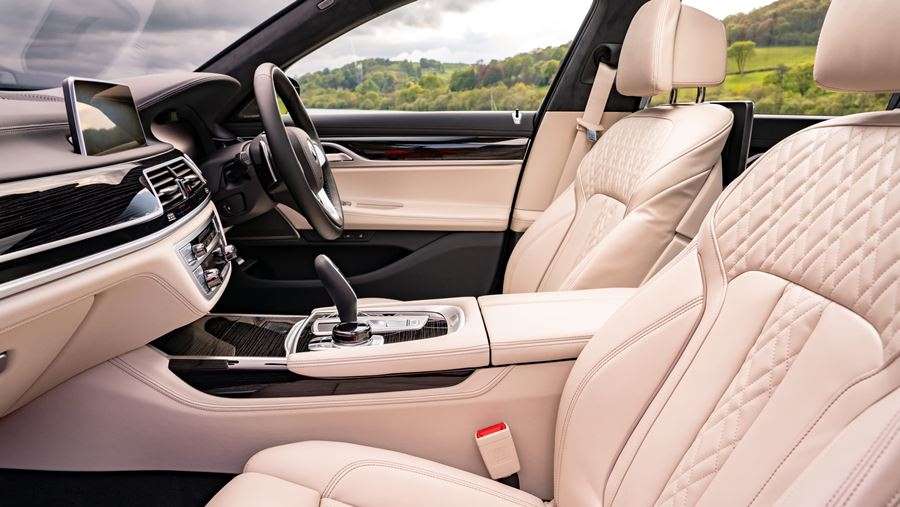
The M Sport trim gives the 7 Series a more athletic look inside and out, capped off by unique alloy wheels, while the M760Li xDrive flagship is essentially its own trim level, with just about every option included.
Options
It's hard to believe you'd need to add a Comfort Plus Pack, but do so and it brings massaging and ventilated seats, scented air and laminated glass designed to help regulate the interior temperature and add soundproofing. A Technology Plus Pack adds driving aids, remote control parking and a head-up display, while the Rear Seat Comfort Plus Pack upgrades the back seats for first-class luxury by adding heated seats and two 10-inch screens on the back of the front seats along with a Blu-ray player and TV.
BMW 7 Series saloon - Practicality & boot space
There's plenty of room to stretch out and the boot is a generous size
The BMW 7 Series saloon has been designed to carry adults in ultimate luxury from the outset, and the latest version is 22mm longer than before. Choose the long-wheelbase version and it gains a full 14cm of additional length, providing even more room for rear passengers to stretch out and sleep on the move.
BMW 7 Series interior space & storage
In standard form, the interior of the 7 Series offers a generous amount of room for both front and rear passengers. Travelling in the rear seats though, is more like first-class air travel than squeezing into the back of a hatchback. That's especially the case if you specify the individual executive lounge rear seats rather than the standard three seat rear bench.
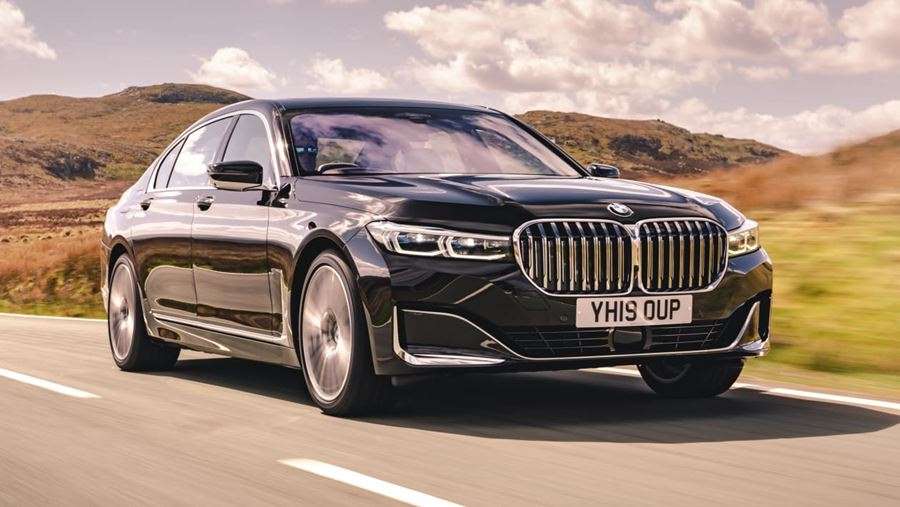
Opt for the extended long-wheelbase version of 7 Series and the rear passenger space is extended further still, meaning that while in transit, you can enjoy a film, work or have a nap. This can be complemented by electrified rear and side window sunblinds and the optional BMW Touch Command, which adds a capacitive touch sensor to control the rear interior lighting. Even more space can be afforded by pressing a button to move and tilt the front passenger seat out of the way.
Boot space
The powered boot lid opens to reveal a large 515-litre boot (10 litres more space than the Audi A8), providing plenty of room for suitcases or golf clubs. Due to the onboard battery in the 745Le plug-in hybrid, boot space is reduced to 429 litres. Those opulent rear seats don't fold down, though, so you can't expand the space.
Towing
While you're unlikely to ever see a 7 Series towing a trailer, its 2,300kg capability means it would actually be rather adept at the task.
BMW 7 Series saloon - Reliability & safety
The BMW 7 Series boasts some of the world's most advanced safety technology
The BMW 7 Series is a hugely complex car, but a decent manufacturer's warranty should allay many fears. It's also laden with safety technology.
BMW 7 Series reliability
It can be daunting buying a car with as much technology and equipment as the 7 Series, but it’s covered by an unlimited-mileage warranty for the first three years. Because this model is essentially a thorough facelift of the previous version, a lot of the new model's underpinnings have also been tried and tested.
Its smaller sibling, the 5 Series, came 40th in our top 100 cars rated by owners in the 2020 Driver Power satisfaction survey. It seems that BMW owners aren’t happy with the running costs, which include high insurance premiums and servicing bills. Surprisingly, BMWs are getting worse than average reviews in the ride and handling and acceleration categories.
Safety
While it's unlikely to be tested by Euro NCAP because of its status as a luxury car sold in small numbers, we'd be amazed if the 7 Series didn't get a five-star result. After all, it's BMW's flagship saloon and a showcase for the brand’s latest safety technology. That includes myriad systems to help warn you of, and even help avoid accidents.
Onboard safety technology includes BMW’s Parking Assistant Plus which is capable of taking control of the car steering and brakes to park the car automatically in parallel or perpendicular parking spaces. This functionality can also be operated via the BMW Display key, with the driver outside the car. Other safety features include the optional Driving Assistant Professional system, which uses a series of cameras and radar to guide the car as you drive, and includes lane change assistance, and can even stop you if you attempt to drive down a one-way street the wrong way.
Audi: We will no longer develop new petrol and diesel engines
The end of the internal combustion engine (SUS) is in sight for many car manufacturers from the Volkswagen Group, given that this concern is already making a big turn towards the sale of electric vehicles, so some of the most famous models will one day be on "for shooting" sheets.
That the end for internal combustion engines in Audi is near, the head of Audi's management, Markus Duesmann, told the media, as reported by zimo.dnevnik.hr.
"EU plans for even stricter Euro 7 standards for CO2 emissions pose a huge technical challenge, which clearly limits the continued use of internal combustion engines. We will no longer develop new SUS engines, but we will adapt existing ones and bring them in line with the new CO2 guidelines, ”said Duesmann.
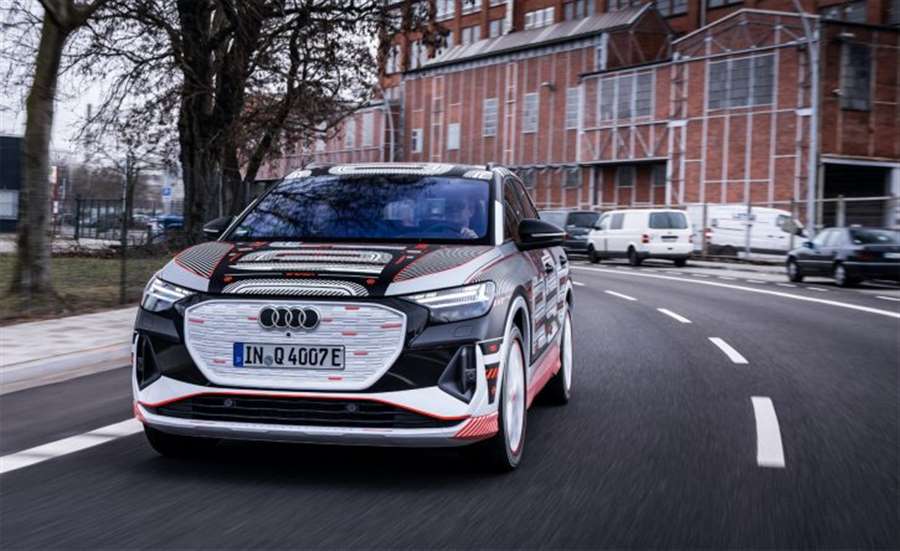
However, it is impossible to predict which versions of the SUS engine will be the first to die out in Audi, or in the VW Group, given how unpredictable the business and environmental conditions are. One thing is for sure - when they start to die out, some entire brands will die out with them.
For now, Audi has officially unveiled two fully electric models - the e-tron GT / RS sedan, which you can read more about here, and then the e-tron Q4 SUV. The sporty TT and R8 models, whose sales are slow, will be inherited by smaller sports electric cars.
The Q4 e-tron should get and buy a version called the Sportback. This will be followed by the replacement of the A8 sedan, and from the old Audi names, it is assumed that the Allroad, Quattro and RS will experience the electric era and come to life in it.
Ford Puma review
The Ford Puma is back - the small, sporty coupe is now a stylish, practical compact SUV that’s good to drive, but lacks cabin space.
We’ve waited a while for Ford to give us a proper compact SUV based on the Fiesta. Until now, the firm’s sole offering in the B-SUV market - the EcoSport - has not been good enough. The new Ford Puma hits the right notes and is precisely what you’d expect of the brand, blending practicality and affordability into a package that’s good to drive.
The Puma’s looks won’t appeal to everyone, but few rivals can better it for boot-space and virtually none can outshine the Puma from behind the wheel - equipment levels are strong too. However, there are more upmarket-feeling and spacious rivals out there for this sort of cash.
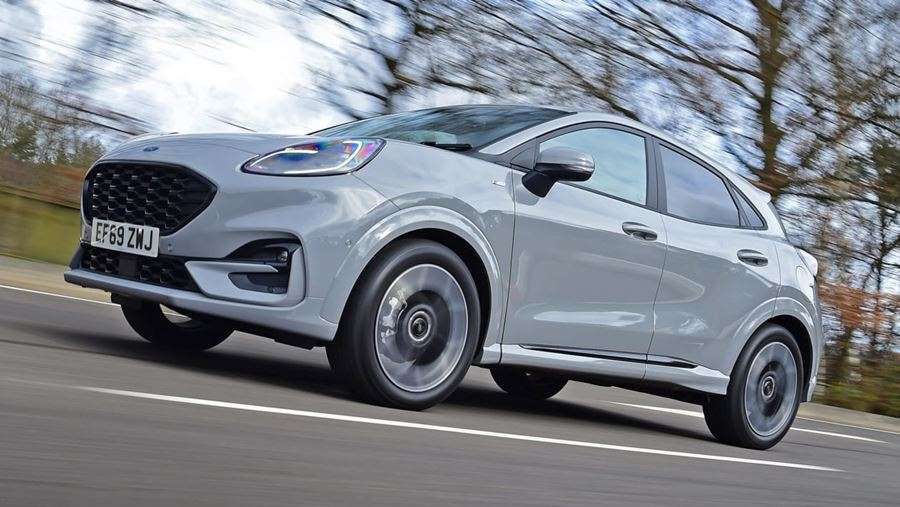
About the Ford Puma
Cast your memory back to 1997, and you may remember Ford launched a fun, small, front-wheel-drive coupe based on what was then the fourth-generation Fiesta. It added a bit of richly needed desirability at the smaller end of the brand’s British line-up. It was a hit - the Ford Puma had landed.
Now, the Puma name is back, and it’s an extremely similar story save for one very important detail; the new Ford Puma is not a small coupe, but a small five-door SUV. It’s based on the current, seventh-generation Fiesta supermini, sharing its chassis and its engines, as it enters a market that’s overflowing with choice at the minute.
Chief rivals include the Renault Captur, the Peugeot 2008, Skoda Kamiq and SEAT Arona, while the handsome Mazda CX-3 and spacious Volkswagen T-Cross offer further possibilities for customers considering a small family SUV. Left-field alternatives include cars like the design-led Nissan Juke, chunky Jeep Renegade and the retro Fiat 500 X.

The Puma line-up isn’t quite as expansive as the Fiesta’s, but there are still plenty of models to choose from and even more engine options will be available soon. The trim structure is very straightforward too, with four core versions: Titanium, ST-Line, ST-Line X and luxury ST-Line Vignale. The Puma ST performance model sits at the top of the range.
The Titanium is the entry-level trim for the Puma range, but it’s still well equipped and finished with flair, including 17-inch alloy wheels, a leather steering wheel, power folding mirrors, navigation via an eight-inch central touchscreen display, cruise control, rear parking sensors and even a wireless charging pad. The other side to this is that the Puma’s starting price is relatively high compared with rivals, many of which start from below £20,000.
ST-Line models add a bit more standard equipment such as a widescreen 12.3-inch digital instrument display and automatic headlamps. But these cars major on sporty touches including a body-kit, different alloy wheels, sports seats and pedals and a sports suspension setup that helps the Puma to shine as one of the best crossovers to drive.
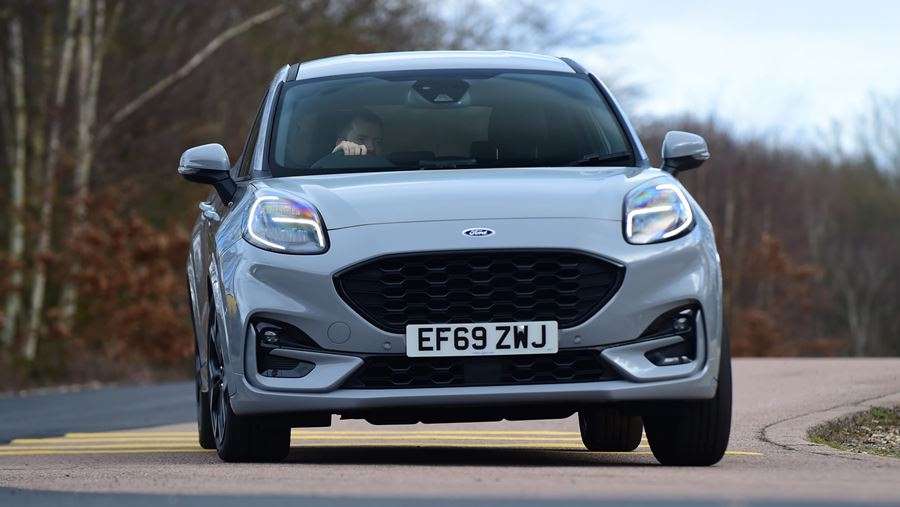
ST-Line X builds on this with luxury features such as partial leather upholstery, privacy glass in the windows and a 10-speaker audio setup from Bang & Olufsen, while the Vignale upgrade brings heated front seats, front parking sensors, keyless entry and Windsor premium leather upholstery.
The Puma is front-wheel-drive only and buyers are offered three engine options. The EcoBoost 125 uses a 123bhp 1.0-litre turbocharged three-cylinder engine as found in the Fiesta, while a 48-volt mild-hybrid version of this engine is also available. It doesn’t bring any additional power, although there is a slight increase in torque, and it introduces marginal reductions in CO2 emissions and gains in fuel economy, too. The third option is another 1.0-litre three-cylinder turbocharged petrol with the same mild-hybrid system, but power is pushed up to 153bhp.
Mild-hybrid versions of the Puma use a six-speed manual gearbox for now, with a seven-speed automatic available with the 123bhp non-hybrid variant, although Ford has plans to introduce the auto transmission throughout the Puma range.
For the performance enthusiast, the Puma ST is arguably the best-handling compact SUV on sale, powered by the Fiesta ST’s 1.5-litre engine for a total of 197bhp.

Ford Puma review - Engines, performance and drive
The Puma’s proven 1.0-litre EcoBoost units are a known quantity, but the mild-hybrid system isn’t flawless.
Ford’s reputation for fun family cars has been sealed with models like the Focus and Fiesta, while the original Puma - though short lived - is another prime example of the Blue Oval’s proficiency in chassis development.
Much the same can be said of this Puma, thanks in the main to the Fiesta chassis that sits beneath it. It links up with a solid 1.0-litre EcoBoost engine to deliver a family crossover that’s good to drive.
When we pitted the Puma up against the Renault Captur and Peugeot 2008, we hailed the Ford as being “easily the best to drive.” The driving position is fundamentally sound, and once you’re settled in, you’ll quickly see why the Puma has won plaudits.
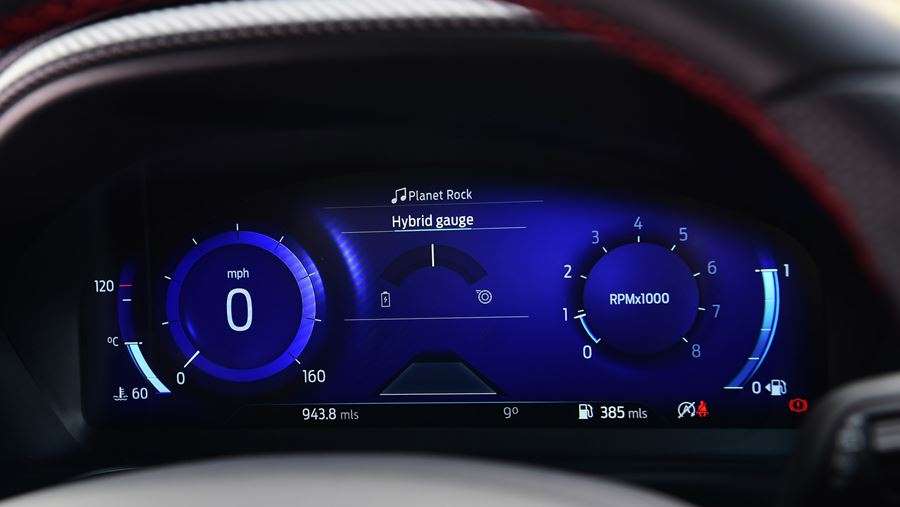
Get on the move and the steering feels light - even if you put the Puma into the Sport mode using the drive mode selector. But, it’s well resolved for a car like this, accurate, keen to re-centre and with a great steering ratio. There’s a good level of grip too, so immediately the Puma feels like a crossover that you can flick through corners nicely. The six-speed gearbox is lovely, too, while Ford’s engineers have also done a good job with the Puma’s suspension.
Even with the sports suspension on the ST-Line model, the damping is very well set up and it has a decent level of compliance. It all comes together to mean that the Puma has brilliant composure and the ability to offer an engaging drive.
The Puma ST is based on the sublime Fiesta ST hot hatchback, which means a 1.5-litre three-cylinder turbocharged engine under the bonnet, making the same 197bhp and 320Nm of torque.
Engines, 0-60 acceleration and top speed
All three engines are based on the same 1.0-litre engine block, but there’s quite a difference between them, owing to the Puma’s various drivetrain technologies and power outputs.
The 1.0-litre EcoBoost engine has been a really strong contender in its various applications over the last few years, and the Puma is another vehicle where this small engine shines. It may no longer be the outright best three-cylinder engine on the market and some engines - such as the TSI units used in the Volkswagen Group cars - may be more refined these days, but you shouldn’t be disappointed.
The 123bhp and 170Nm torque served up by the base model is enough for most family motoring, propelling the Puma to 62mph in 10.0 seconds and on to a top speed of 119mph.
Hybrid badge
What is a hybrid car? Mild hybrids, full hybrids and plug-in hybrids explained
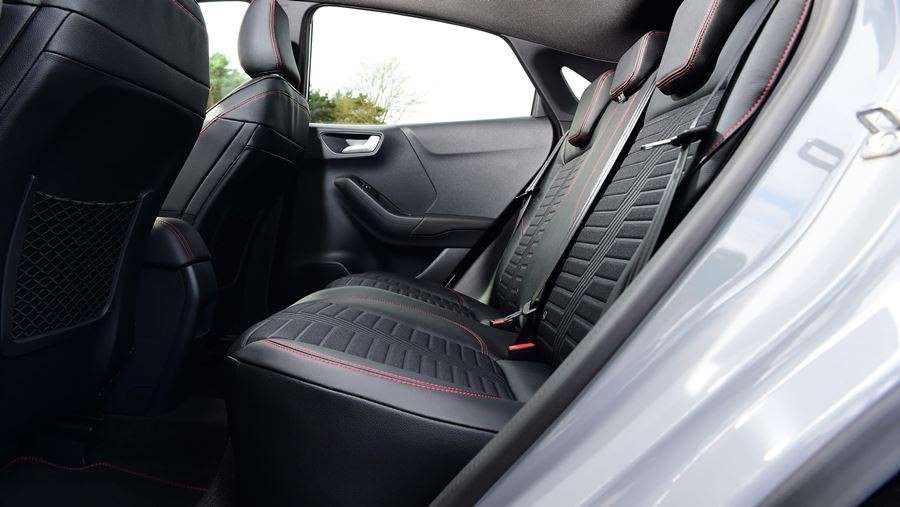
Pick the mild-hybrid version and the power stays at 123bhp, but torque improves to 210Nm thanks to the small amount of electrical assistance. Top speed is still 119mph, but the 0-62mph time falls a little to 9.8 seconds. The real benefit is lower CO2 emissions from the exhaust pipe and better running costs from improved fuel economy, which we’ll come to on the next page.
The only downside to the mild-hybrid system is that to fill the small battery pack with energy, the Puma features a very minor amount of brake energy regeneration. It’s set at a constant, unchangeable level, that’s just about detectable when you lift off the throttle and feel the car slow more quickly than it otherwise would, and takes a little getting used to.
If you need more power, the 153bhp car has you covered. It also has braking recuperation that cannot be altered in strength, but it takes 8.9 seconds to reach 62mph from standstill and goes on to a top speed of 124mph.
The 197bhp ST performance model dispatches the same sprint in 6.7 seconds, with a 137mph maximum.
Ford Puma review - MPG, CO2 and running costs
Ford uses proven 1.0-litre petrol engines for the Puma, with mild-hybrid technology helping to improve economy and emissions.
Ford’s 1.0-litre three-cylinder EcoBoost unit has received much praise for its versatility and ability to blend decent power with good returns from a tank of fuel. So, it’s probably no great surprise that the engine is at the core of the Puma range.
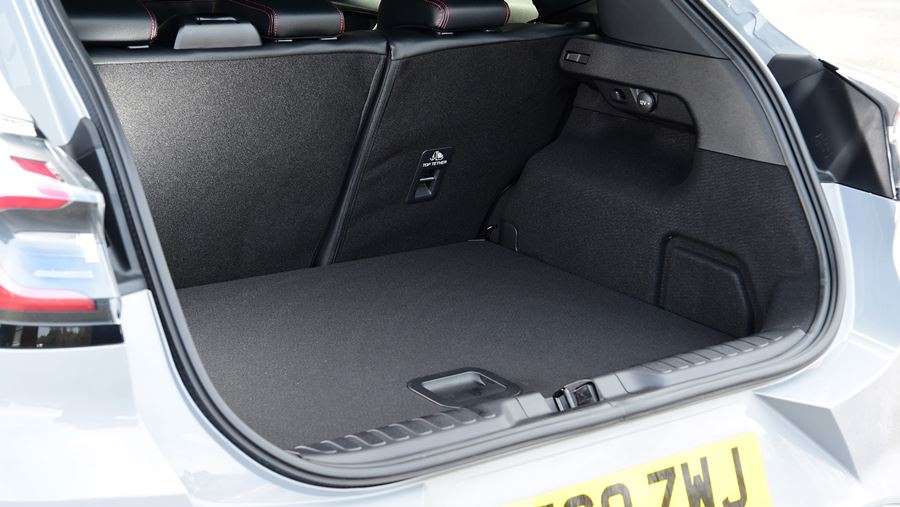
The flexible 1.0-litre powerplant comes in three guises for Puma customers. The base 123bhp version returns a maximum 46.3mpg, with 138g/km of CO2, while the same unit with 48-volt mild-hybrid assistance is able to improve on these figures a little by delivering a claimed 50.4mpg and CO2 levels of 127g/km.
The 153bhp variant produces the same economy and CO2 figures as its lower-powered sibling, while the 197bhp Puma ST still performs pretty well with 41.5mpg on the combined cycle and 155g/km of CO2.
Most economical SUVs, 4x4s and crossovers 2021
The mild-hybrid system captures kinetic energy naturally lost while driving, particularly during braking, before storing it as electricity in a small battery. This electrical energy is then used to assist the engine during acceleration, reducing the amount of petrol needed to make decent progress.
Drivers can view a display on the digital instrument panel to see exactly when the system is in action. Alongside it, cylinder deactivation means the engine can run on two cylinders where driving conditions allow, to save more fuel.
Insurance groups
Insurance premiums for the Puma range should be competitive with those of rivals. The base 123bhp Titanium model comes in at group 11, while the ST-Line Vignale cars with 153bhp occupy group 15. The 197bhp ST variant is in group 22.
Competitors such as the Renault Captur start at group 8 for an entry-level 99bhp version and move through to group 21 for a top-of-the range model with 152bhp.
Depreciation
Our experts predict the Ford Puma will retain a healthy 51% of its original value over 3 years and 36,000 miles, whereas the Renault Captur keeps an average of 43% over the same period.
Ford Puma review - Interior, design and technology
The Ford Puma has a familiar cabin design and good levels of standard kit, but overall quality can’t match rivals.
Ford’s new small SUV is based on the best-selling Fiesta, which is no bad thing. Despite being one of the smaller B-segment models, the Puma has ensured it stands out from competitors with a distinctive design and impressive levels of standard equipment.
In the cabin, the dash and centre console will be familiar to those who’ve peered inside a recent Focus or Fiesta, although the visible plastics aren’t the Puma’s greatest quality. There’s far too much hard black stuff to be found, while other small SUVs are available with nicer interiors, and for similar money.
Ford offers four individual trim levels for the Puma. The entry-level Titanium is still very well equipped with 17-inch alloy wheels, LED rear lights and daytime running lights, body-coloured exterior trim, power-folding heated mirrors, rear parking sensors and selectable drive modes.
ST-Line models include a muscular body-kit, sports suspension, a leather sports steering wheel and alloy pedals, although the ST-Line X car adds stylish 18-inch wheels, partial leather seat trim, privacy glass and carbon-effect interior accents.
The luxury Vignale version ups the luxury count with heated seats, Windsor premium leather upholstery, a heated steering wheel, front parking sensors and keyless entry, while the ST car features 19-inch alloy wheels and a body styling kit.
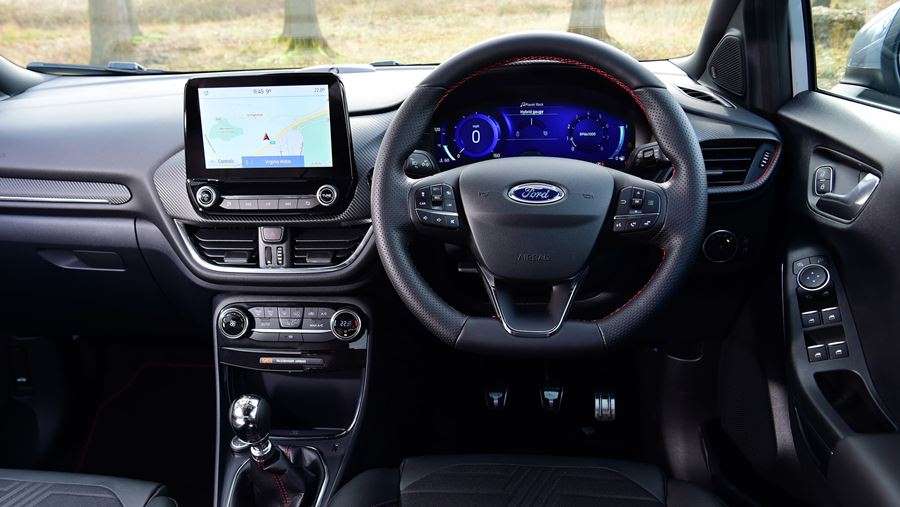
Sat-nav, stereo and infotainment
All Puma models come with Ford’s SYNC 3 infotainment system, including navigation, Bluetooth, a DAB radio and Apple CarPlay and Android Auto functionality. There’s also a wireless charging pad as standard. Bearing in mind the high list prices as you climb the range, the Titanium trim offers a sweet spot in terms of equipment and on-board tech.
ST-Line cars feature a 12.3-inch digital instrument display which, along with the central touchscreen, is sharp and easy to navigate. And, if you feel the need for better quality audio while on the move, the ST-Line X models add a B&O Premium stereo with 10 speakers.
Ford Puma review - Practicality, comfort and boot space
Although smaller than most rivals, the Ford Puma remains practical for family use and offers clever storage solutions.
Ford has worked hard to ensure the compact Puma combines its athletic low stance with plenty of practicality and comfort. From the driver’s seat, the links to the Fiesta’s chassis are clear, with ability to tackle the twisty stuff with vigour as well as being a solid, quiet performer at motorway speeds.
ST-Line cars get sports suspension, and while on the firmer end of the spectrum for SUVs of this size, it’s not overly harsh. The driving position definitely feels sportier while there’s a great level of adjustment in the seat and steering wheel, a typical Ford trait.
Size
The Puma is one of the smaller options in the supermini sized SUV class. It measures 4,207mm in length, 1,805mm wide and stands 1,537 tall. By comparison, the Peugeot 2008 and Mazda CX-3 are 93mm and 68mm longer, respectively.
Leg room, head room & passenger space
The Puma manages to maintain decent passenger space, despite its sloping roofline. Room up front is very good, while the rear bench is an acceptable size.
Passenger space in the rear is compromised when compared with a Renault Captur. Passengers in the back sit higher up, which brings your legs back towards the seat base, so although there’s enough space overall, the seating position might not be as comfortable.
Boot
A boot of 456 litres is on-par with competitors in this class, and there’s virtually no lip to get over, so awkward items shouldn’t be too tricky to load. In comparison, the Peugeot 2008 offers 434 litres of boot space and the Renault Captur 12 litres less than that, although the Captur has an ace up its sleeve in the form of a sliding rear bench seat. When the bench is pushed all the way forward it frees up a 536-litre capacity.
One area where Ford has been rather clever is in the Puma‘s adjustable boot floor with the so-called ‘Megabox’ hidden storage area beneath. This is a 68-litre plastic compartment that you can use to store muddy boots or wet clothes, for example. It also has a drain plug so you can hose it out. Plus, Ford claims that using the MegaBox allows you to stand a golf bag upright in the Puma’s boot.
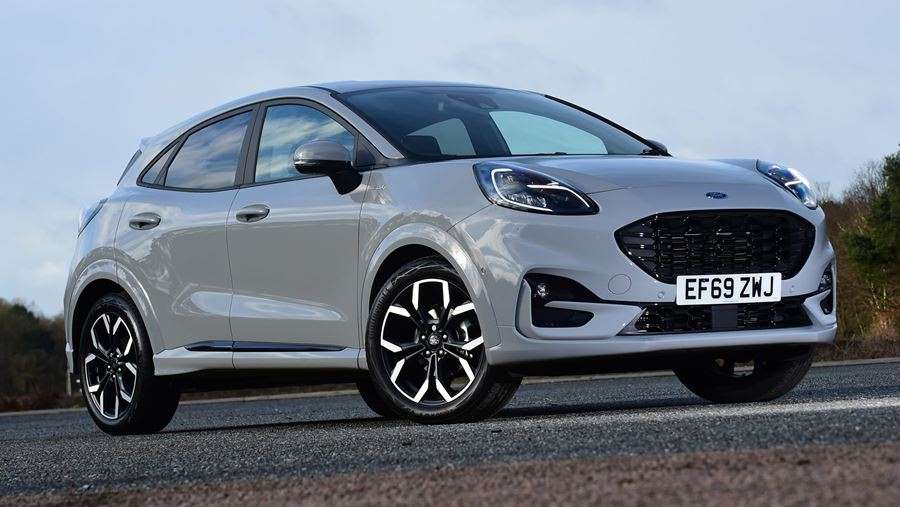
Ford Puma review - Reliability and safety
Ford has a lot riding on the success of the Puma. It’s previous effort at a small SUV, the EcoSport, was a poor one, so the brand has to get this right. Fortunately, the Puma arrives with proven engines, a chassis based on the best-selling Fiesta and interior tech already in use across other model ranges. We’d expect the Puma to be a car you can rely on, and also one that keeps the driver, passengers and other road users as safe as possible.
All models include cruise control, a lane keeping aid with departure warning, Pre-Collision Assist with Autonomous Emergency Braking, Pedestrian/Cyclist Detection and Post-Collision Braking. Other useful features include auto headlights, rain-sensing wipers and a tyre pressure monitoring system.
Those wishing to upgrade further can opt for the Driver Assistance pack (£900), which adds a blind spot warning, adaptive cruise control and a rear view camera among other features.
The Puma was tested by Euro NCAP in 2019 and achieved a full five-star rating. Adult and child protection was rated at 94% and 84%, respectively, while the car scored 77% for pedestrian safety.
Although Ford finished a disappointing 24th out of 30 manufacturers in our 2020 Driver Power customer satisfaction survey, it’ll be looking towards cars like the new Puma to guide it to improved results next time.
Warranty
Every new Ford car comes with a 3-year/60,000 mile warranty. There’s also the benefit of Ford Assistance for 1 year, providing roadside cover in the UK and throughout Europe.
If you plan on keeping your car for longer than three years or are a high mileage driver, you can extend the standard warranty to either 4 years/80,000 miles or 5 years/100,000 miles.
Servicing
Ford offers the Ford Protect Service Plan giving you the option of scheduled services and extended Ford Assistance. It covers scheduled servicing including associated parts and labour, and vehicle hire for up to 7 days. The Ford Protect Service Plan can be purchased any time before the first service is due.
These are the most expensive car breakdowns - When the repair costs more than the whole vehicle!
Usually, car breakdowns can be avoided by regular servicing, but there are also those that the owner cannot influence with his behavior and driving habits! Regardless of which group they belong to, repairs of 30, 50 or 70 thousand kuna will be equally hateful.
Breakdowns and their repairs are an eternal topic for all car owners, but also for those who are just preparing to become one.
Even those who drive in new or at least newer vehicles are afraid of the very mention of the debate on the most expensive car parts and the most demanding repairs, and for those whose cars are closer to the Croatian age average (according to the latest available data 12.6 years) or already transferred, such and similar stories almost become a taboo topic.
And they shouldn't be, just as those who are just getting ready to buy a used car have to think about them in time.
That’s why it’s never worse to repeat some of the most expensive breakdowns that can befall car owners.

Electronics, flywheel, injectors, fuel pumps…, all these are parts that can quickly make it easier for you to easily exceed the average Croatian salary.
But even such situations can look like chamomile compared to the really expensive ones, for which we give only a few examples. Some of them are expected, and some not at all.
Engine failures
An engine accident is the ultimate nightmare of every car owner, regardless of whether he was driving an older and cheaper or a newer and more expensive car.
In the background of this problem in case of improper maintenance is often a timing belt: if it does not change in time, its rupture will cause a familiar horror scenario, with the pistons hitting the valves, and depending on the case and damage to guides and seats the cylinder heads themselves.
In each of these cases, the unfortunate owner can count on tens of thousands of kunas in damage from the start, which in practice means that it is sometimes more cost-effective and easier to replace the entire engine.
Of course used, not new, because otherwise the repair could cost more than the value of the whole vehicle. So, with great service, you should never play or postpone it.
Gearboxes
Automatic transmissions used to be a rarity, but today they are a daily occurrence for a growing number of car owners.
We know several types of them, from classic, through those continuously variable gear ratios (CVT), to fast and efficient and sophisticated gearboxes with two clutches (DCT, PDK, EDC…).
And all of them, in addition to the comfort of use in everyday rides, have one more thing in common: if serious problems occur, repairs are very expensive and in case they remain below ten thousand kuna, the owner can almost be considered lucky.
Because sometimes repairs are not possible, but the only solution is to replace the entire assembly, which in the case of repaired can be counted in tens of thousands of kunas, and a new gearbox sometimes more than 100,000 kunas!
The causes of failure, for example, often lie in the insufficient amount of oil in the gearbox, or its untimely change and the entry of metal shavings into the assembly itself.
So again in irregular servicing.
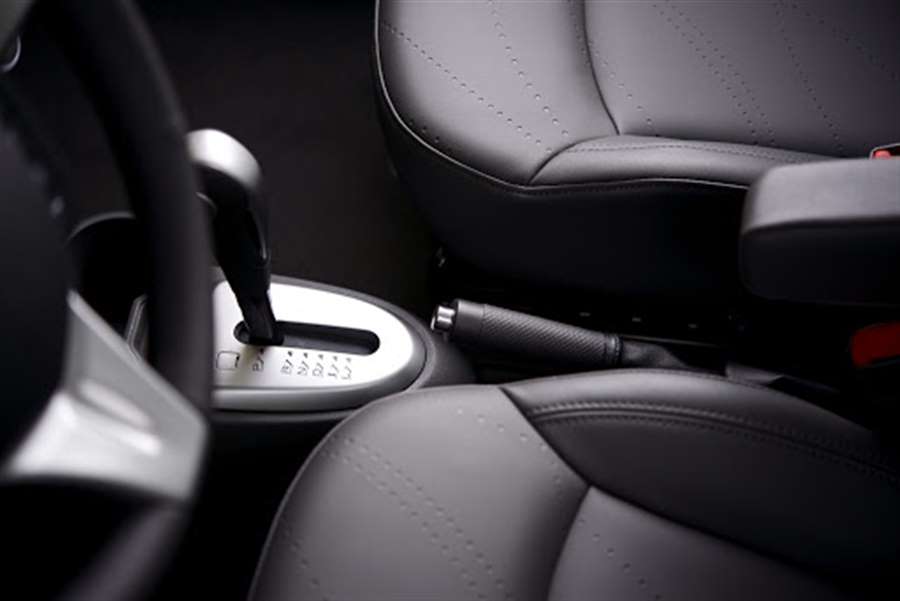
Differentials
The same goes for another vital car assembly, without which driving as we know it and enjoy it every day would not be possible.
The differential, whose task is to enable the wheels to rotate on the same axle at different speeds, just like the above-mentioned parts, require proper lubrication for their normal functioning.
This means that the key to a peaceful sleep in most cases and here is regular servicing, or oil change at prescribed intervals.
The electronic key became a deadly malfunction
Even more often, especially if it is official vehicles that are often used more and heavier than private ones, but this should not be a problem because this is a really small cost that counts in the hundreds of kunas.
Otherwise, if the repair is not possible, and the owner has the misfortune that he cannot find anything suitable even on the scrap yard, he will be doomed to buy a new differential.
This could ultimately cost him dizzying amounts again, because depending on the model, the amounts can be around 30, 40, and even 60 and more thousand kunas.
Air conditioning compressors
Unlike engines and transmissions, one can live in a car without air conditioning, at least in theory.
But such an attitude, if one is willing to defend it, usually begins to melt with the first rays of the sun, and after the temperature approaches the mark of 30 degrees Celsius, all the alarm bells ring.
If the problem is one of those expected, such as insufficient oil or gas levels in the system, which inevitably happens with time and exploitation, the solution is relatively simple and financially acceptable.
Checking the pressure, extracting the remnants of old liquids and refilling with new ones, as well as replacing the filter and disinfection are sufficient in most cases, when the air conditioning system is maintained regularly.
However, if major problems occur, such as a complete blockage of the system, in the worst cases a complete replacement of the compressor will be necessary, and such an operation can cost more than ten thousand kuna.
Defective airbags
Unlike the above examples, an airbag in a car does not depend on regular maintenance and will not break down on its own, but the need to replace it is certainly among the most expensive expenses that a car owner can face.
The pillows, of course, need to be replaced with new ones if the original ones have been activated, ie in the event of a collision, which in itself means that the costs in this case will be considerable.
But without including in the calculation here all the other parts that were damaged in the accident, but also the airbag itself, if, say, the driver himself caused the accident and there is no hull, it will cause quite a headache.
Because this part never changes on its own, but the calculation should include parts or the whole armature, belts, sensors and control unit, which also almost never costs less than ten, and can go up to 40 or 50 thousand.
Cruise control failures
Sophisticated modern cars are loaded with various assistance systems, such as radar to maintain a safe distance from the vehicle in front.
However, this does not automatically mean that they are immune to all types of traffic situations, so, for example, you can damage them at low speeds in the parking lot.
And that, of course, means that you have to replace them with new ones, because it is quite clear that repair in such cases is not possible as a rule.
In addition, just as is the case with airbags, you should know that the replacement of the radar system itself in some cases is not possible, but with it, depending on the make and model, and pulls special holders, masks, control electronics…
2022 Audi RS e-tron GT Whirs Toward the Future
As Audi's version of the Porsche Taycan, the new RS e-tron GT is an exciting, Tesla-chasing ride.
To make sure the 2022 e-tron GT stands out among the brand's other electric offerings, Audi asked sound engineers to develop a new soundtrack specifically for the e-tron GT and RS e-tron GT models. Before you go looking for it on Spotify, we'll tell you that this "song" is played just for the e-tron driver. It's a sort of intergalactic hum that transforms into a turbine whoosh as you accelerate. It says, "I am the future," and it'll have you thinking dilithium crystals and calling a Scottish engineer to see how everything is going, but it's not quite right for the e-tron.
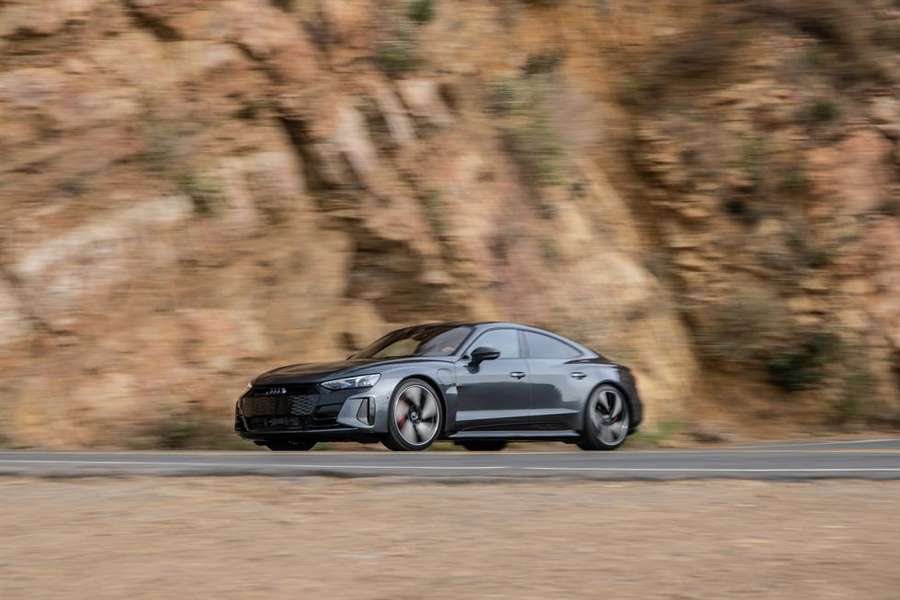
The sound Audi should have used—and the one playing in my head right before hitting the accelerator—is the adrenaline-juicing click, click, click of a roller coaster on an upward climb. Flooring an e-tron GT produces the same lung-flattening rush of acceleration as a coaster in freefall.
Audi’s 2022 RS e-tron GT Adds More Speed to the GT
The e-tron GT has a twin at the Porsche dealer. The e-tron shares its platform, 800-volt electrical architecture, front and rear electric motors, two-speed automatic transmission at the rear axle, air springs, and all-wheel steering with the Porsche Taycan. While the Taycan offers a single-motor, rear-wheel-drive setup as well as the dual-motor-driven AWD 4S, Turbo, Turbo S, and Cross-Turismo, at least for now, the all-wheel-drive GT comes two ways, the 522-hp e-tron GT and the 637-hp RS e-tron GT. Accessing all of those horses requires using launch control, and then you only get the power for 2.5 seconds.
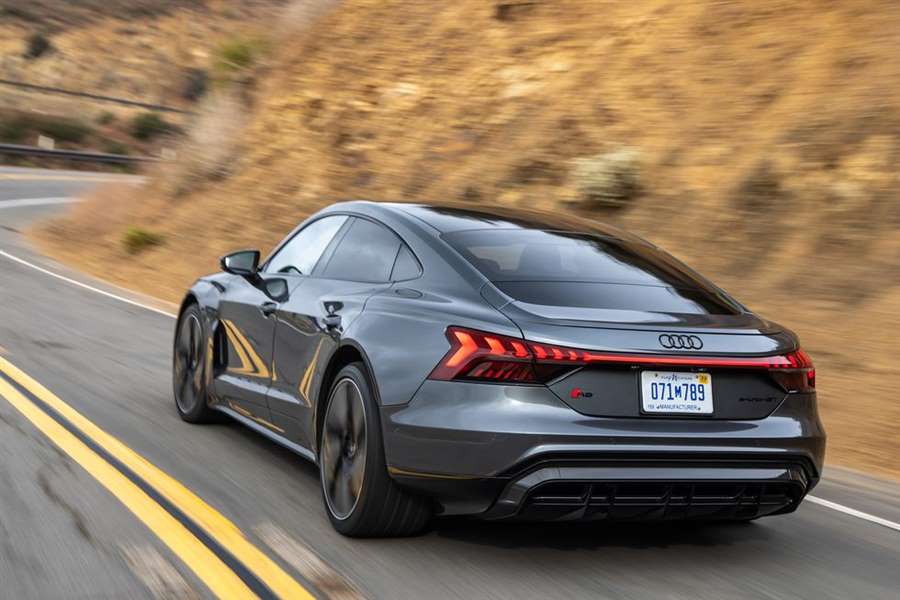
With typical use, you get a still heady 469 horses in the GT and 590 in the RS. The difference is one you're unlikely to miss on your drive to work. Audi's acceleration claims back up the roller-coaster feeling. Audi claims the base GT will hit 60 mph in 3.9 seconds with the RS reducing that to 3.1 seconds. While those numbers are important, the e-tron GT and RS's range figures will likely mean more to buyers. EPA numbers aren’t ready yet, but Audi estimates 238 for the regular version and 232 for the RS. That's not the sort of range that leads to bragging, especially if the conversation turns to Teslas.
On the road, the RS GT tours grandly. It hums and hauls so smoothly that the big numbers on the speedometer readout might come as a surprise. The low, hefty weight of electric cars works in their favor when it comes to stable cornering, and 590 electric horses are more than enough to reshape your eyeballs. The GT's biggest challenges come from not having the longest range and not being the quickest or flashiest thrill ride in the park.
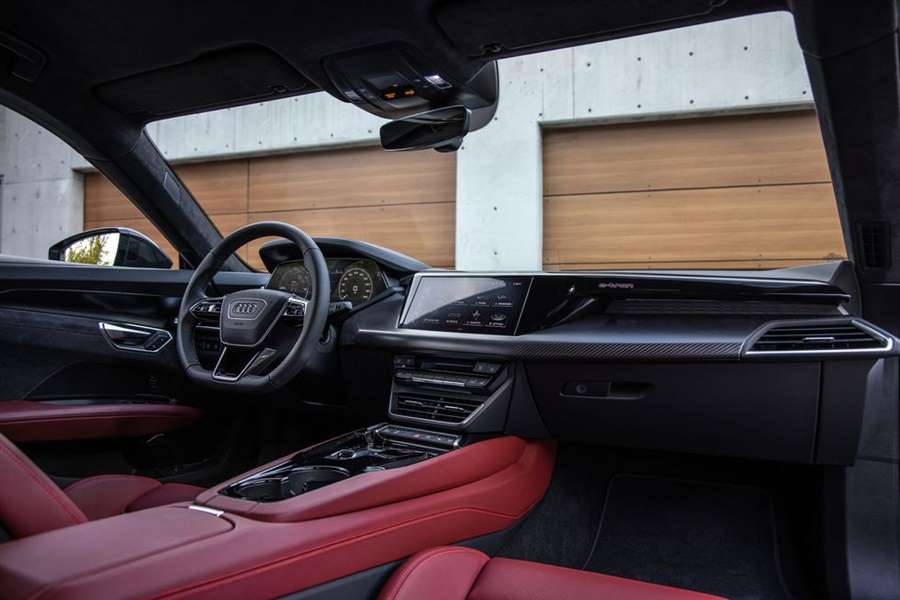
Audi gets points for using the steering-wheel paddles to control regenerative braking. It's just the sort of setting you might want to change on the fly, say, heading down a steep hill or coasting along in highway traffic, and being able to adjust it without having to dive into a settings menu is smart. The middle setting will feel the most familiar to gas-engine aficionados, and the max regen is almost but not quite aggressive enough to allow for one-pedal driving. The RS we drove had optional rear-wheel steering as well as the standard dynamic steering, so not only was the steering ratio changing depending on our speed, the rear wheels also turn to stabilize at high speeds or reduce the turning radius in parking lots. Steering efforts are light, almost too light at slow speeds, but once you get used to it, you'll be flipping tight U-turns just for the fun of it.
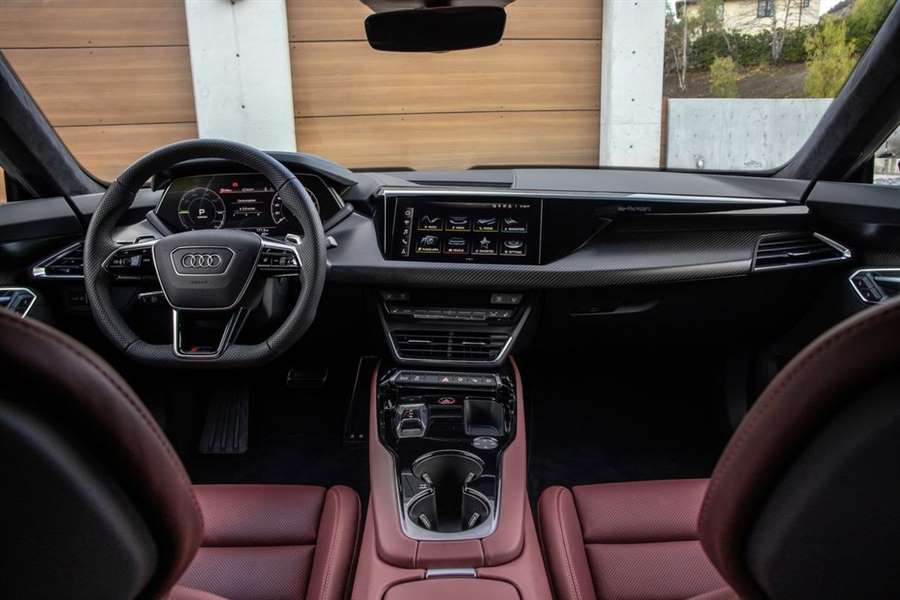
Audi tilts the controls towards the driver, and everything you need is within easy reach. EVs have conditioned us to expect tech-focused or even minimalist interiors. The GT has a crisp digital display in front of the driver and a 10.1-inch touchscreen in the middle of the instrument panel, but there are—gasp—buttons for the climate control.
The GT does play into another electric-car expectation, however, that of the environmentally conscious and possibly vegan buyer. Leather-free interiors and recycled materials come standard, but if you want to sit on cow hides you can order up a less vegan-friendly version. Whether your seats were once alive or never alive, the GT supposedly seats five; just be sure to call shotgun. No one will enjoy the middle seat in the back. Legroom for the outboard rear seats is excellent thanks to cutouts in the battery, which mean deeper pockets for your tootsies. Headroom isn't as generous, as you pay for the stylish sweep of the roof with tiny back windows and an encroaching C-pillar.
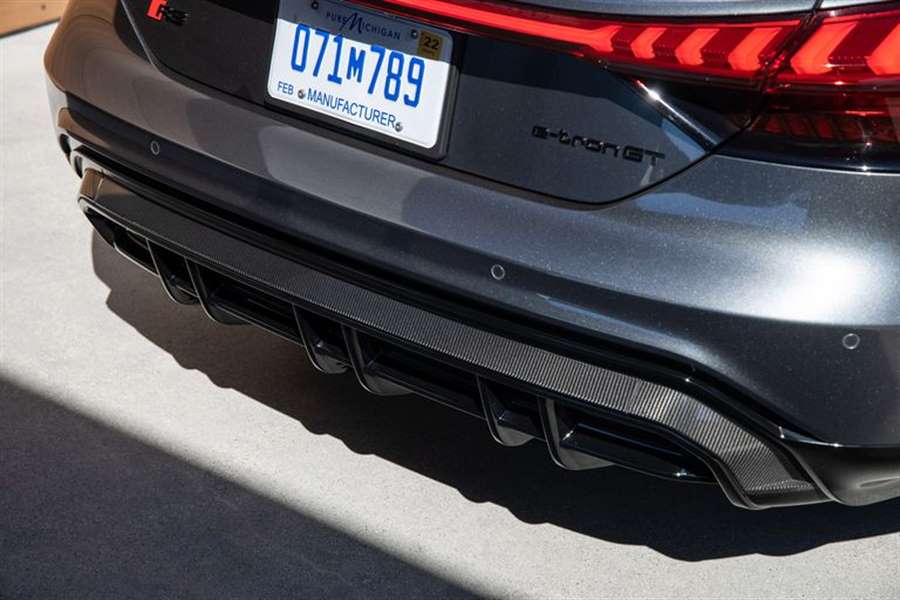
Audi's brave new EVs start at $100,945 for the e-tron GT, a price that lines up with the similarly quick Taycan 4S. Bring a $93,190 check to the Tesla store and you'll drive away in the much quicker Model S Performance AWD. The RS version, with its carbon-fiber roof and extra power, starts at $140,945. That money would put you into an 1100-hp Model S Plaid+ AWD, which is likely to be the quickest EV when it actually reaches buyers.
Sizewise, the e-tron is about same length as an A7, but it's dramatically lower and wider. The wide rear end and taillights look particularly great, but in front, the wide crossbar through the grille visually weighs down the front end. Overall, the e-tron GT reads elegant and muscular. It's not a game changer coming after the Taycan or even the still-powerful grandfather of the segment, the Model S, but it's quite a ride.

